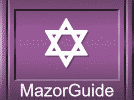|




|
The Torah's
Weekly Portions
Exodus/Shmot
- Tetzaveh 101
Reb Yosef - Posted March, 2001
Back
to Torah Portions Archive
|
Parashah: |
Tetzaveh |
|
Sefer (Book) |
Shmot (Exodus) |
|
Beginning Perek (Chapter): |
Chav-Zayin (27) |
|
Beginning Pasuk (Verse): |
Chav (20) |
|
Concluding Perek: |
Lamed (30) |
|
Concluding Pasuk: |
Yud (10) |
·
·
·
·
·
·
Key Points of
Parashat Tetzaveh:
This entire Parashah discusses the vestments worn by
the Kohen Gadol (High Priest).
Once or twice each year, I will discuss the element of
Chumash that first caught my eye, and that is when we
read along and, out of the blue, a word is inserted that
does not seem at all congruous with the rest of the
language. This week's Parashah presents just such an
occurrence.
This Week's
Psukim - Perek Chav-Tet (29):
-
You shall make a Breastplate of Judgment of a woven
design, like the craftsmanship of the Ephod shall
you make it, of gold; turquoise, purple, and scarlet wool;
and linen -- twisted together -- shall you make it: -
Into the Breastplate of Judgment shall you place the Urim and the
Tumim, and they shall be on Aaron's heart when he comes before
Hashem; and Aaron shall bear the judgment of the Children of
Israel on his heart constantly before Hashem:
Translation by:
The Focus of this Week:
Notice the word "Judgment." The Stone Edition Chumash
elects to capitalize the word which certainly draws attention to
it. The Hebrew is khoshen (khet shin nun sofit) mishpat (mem
shin pey tet). What does the breastplate have to do with
judgment (mishpat)?
Commentary from the
Stone Edition Chumash:
(30) The Urim and the Tumim. As noted above, the
Breastplate was folded in half to form a pouch-like pocket. Into
it Moses was to insert a slip of parchment containing the
Ineffable Name [according to Ramban, there was more than
one Name]. This Name was called Urim, from the Hebrew word
"or", light, because it would cause individual letters of the
tribal names on the Breastplate to light up; and it was called
Tumim, from the word for completeness because if read in the
proper order, these luminous letters presented complete and true
answers to the questions of national import that the Kohen
Gadol would ask of God (Rashi
from Yoma 73b).
Ramban gives an example of how this process took place.
When the Jewish people crossed the Jordan and had to undertake the
conquest of the Land, the question arose which tribe should begin
the war against the Canaanites. Phineas the Kohen Gadol
entered the Tabernacle and posed the question. The name Judah lit
up, and also the letters yud-aleph-lamed-hay. The Kohen
had to know what this combination of letters represented, because
they could be placed in several orders, thus forming different
combinations of words. A Divine spirit gave him the wisdom to know
that the message of the Urim v'Tumim was [the tribe of]
Judah shall go forth [to wage war] (see Judges 1:1-2).
The Vilna Gaon gives a classic interpretation of how the
message of the Urim v'Tumim could be misunderstood. When
Hannah, the future mother of the prophet Samuel, entered the
Tabernacle to pray for a child, the Kohen Gadol Eli saw her
unusual demeanor and reckoned her to be a drunkard, rather than a
supremely righteous woman (I Samuel 1:13). The Gaon
contends that Eli consulted the Urim v'Tumim regarding
Hannah, and the letters shin-chav-resh-hay lit up. Instead
of reading them correctly as ksherah, a worthy woman, Eli
mistakenly read the letters in the wrong order as shikorah,
a drunken woman.
Ramban adds that Moses himself wrote this Name [or Names],
because only he had the spiritual knowledge and greatness to know
what had to be done. This is why the Urim v'Tumim is not
mentioned among the vestments and artifacts of the Tabernacle that
were made by artisans or contributed by the people.
During the waning years of the First Temple Era, King Josiah
realized that Eretz Yisrael would be conquered and, fearing
that the most sacred parts of the Temple would fall into profane
hands, he removed the Urim v'Tumim from the Breastplate and
hid it, and he also hid the Ark containing the Tablets, and the
anointment oil. None of them were found during the period of the
Second Temple. While their absence denoted a diminished degree of
holiness, it did not prevent the performance of the Temple
service. It did mean, however, that from that time onward, the
Kohen Gadol could not present Israel's urgent questions for
God's response.
Commentary by Rav
Samson Raphael Hirsch:
Rav Hirsch has no commentaries on this particular topic. As you
can see, however, the other mefarshim (commentators or
commentaries) are extensive.
Commentary by Reb
Yosef:
As we can see, that one word, that seems so out of place, has a
great deal of meaning and importance in the overall picture. This
further illustrates that each word in the Torah is of critical
importance. Is it any wonder that God prohibited adding, deleting,
or changing a second letter?
________
Translations in Torah Portions of the week are partially taken from the ArtScroll
Stone Edition Chumash and from
Rav Samson Raphael Hirsch Chumash
Back to
Torah Portions Archive
click
here or Torah for Tots
|
|















